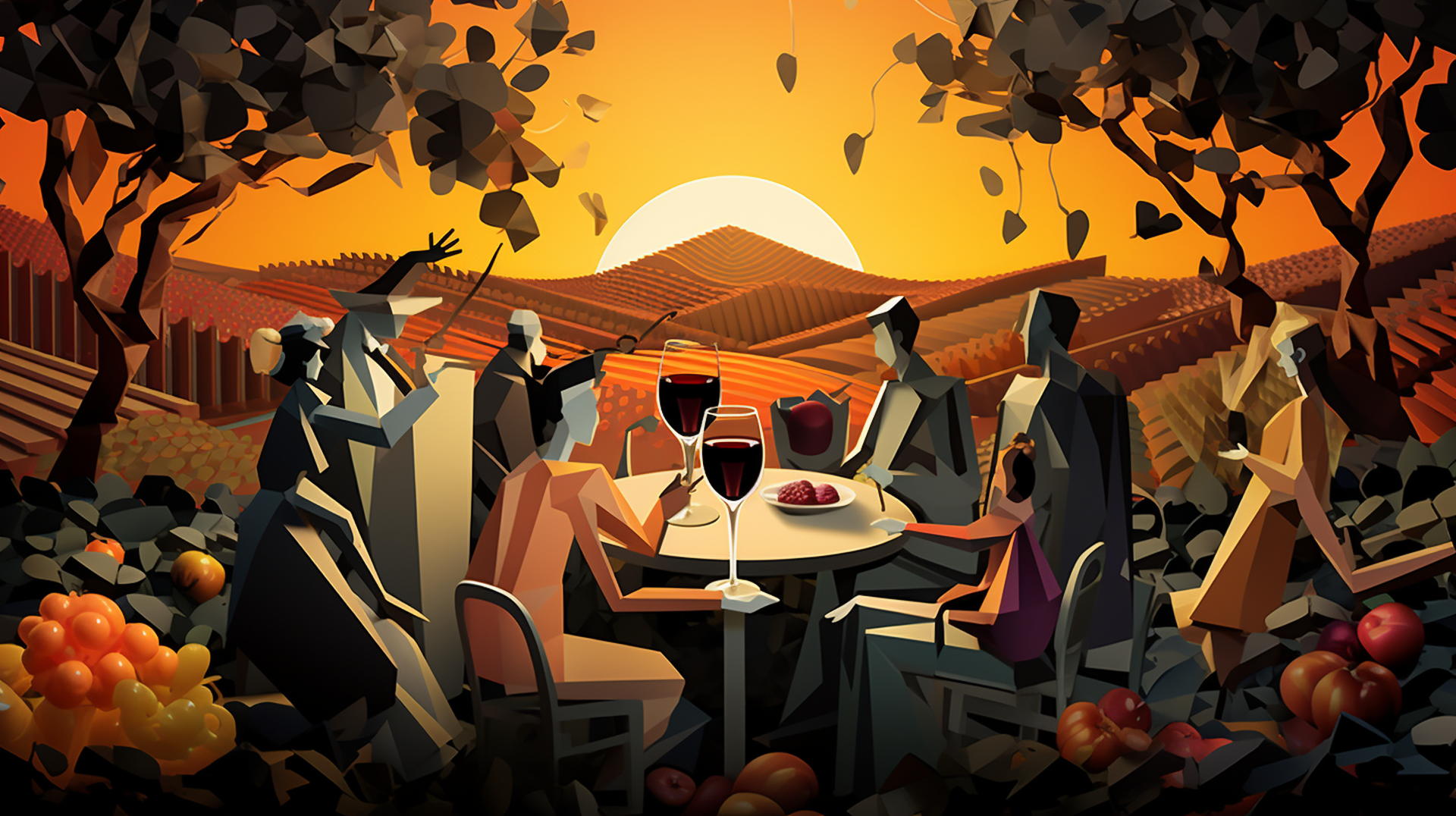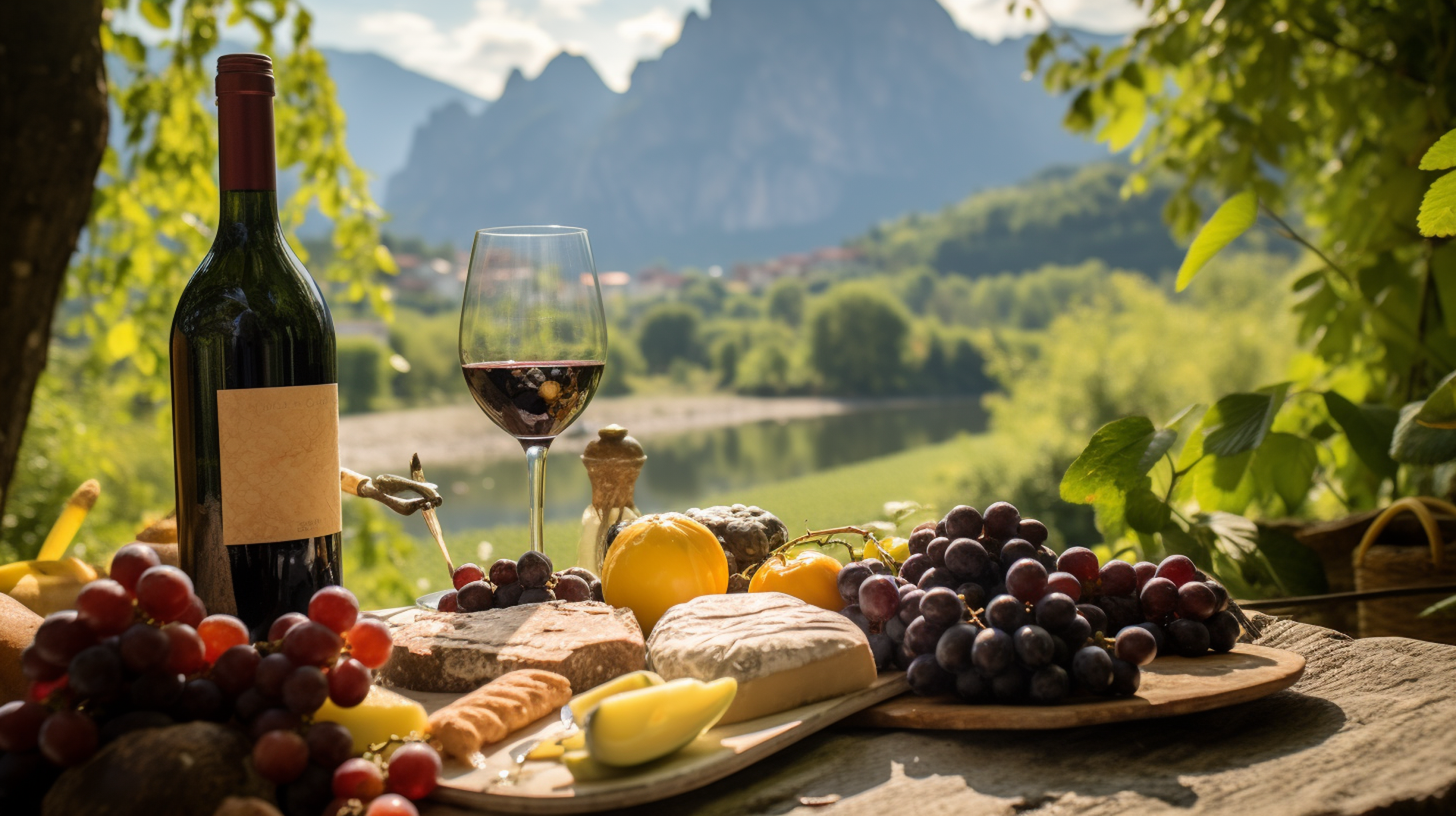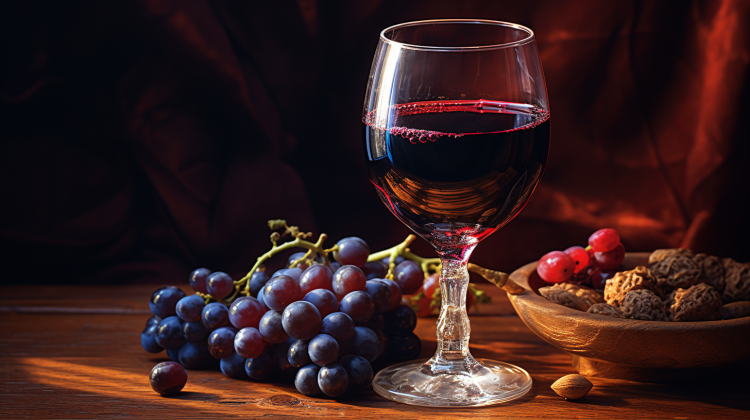Are you looking to become the king of wines? Look no further than the powerful and intense Amarone from the Veneto region of Italy. This full-bodied red wine is produced using a unique technique that results in an exquisite flavor profile. Join us on this journey as we explore the fascinating world of Amarone and discover why it’s the perfect choice for any occasion. So, grab a glass and let’s become experts together!
What is Amarone Wine
Amarone is a rich, expressive red wine from Italy’s Veneto region that’s made with a unique grape-drying technique. It comes from Valpolicella, and is made using the appassimento method, where grapes are dried for several months before being fermented and aged. Amarone is a blend of grape varieties, including Corvina, Rondinella, and Molinara, and is characterized by its full-bodied and intense flavor. It has a high tannin content, giving it robustness and a lingering finish. Its aromas are of dark fruits such as cherries and plums, along with hints of spice, tobacco, and chocolate. It pairs well with richer dishes, hard cheeses, and chocolate-based desserts.
Notable producers of Amarone wine include Bertani, Dal Forno Romano, Quintarelli, and Masi. Valpolicella Ripasso is a byproduct of Amarone production, making it a more affordable alternative. Amarone is a favorite among wine enthusiasts, making it highly sought after.
The History of Amarone
Amarone has a long history, going back to Ancient Rome. Legend has it that Amarone was created by accident, and ‘Valpolicella’ translates to ‘valley of many cellars’, a nod to the area’s long-standing tradition of wine production. Let’s delve into the history of Amarone.

Amarone’s Roman Roots
Explore the centuries-old Roman roots of Amarone wine. It all began when the Romans discovered this powerful and robust Italian wine. It was highly sought after for its high alcohol content and unique flavor profile. Today, Amarone is still as popular as ever, and here are some of its Roman roots:
- Amarone dates back to Ancient Rome and was favored by the Romans for its high alcohol content.
- Legend has it that Amarone was created accidentally when a barrel of Recioto over-fermented, resulting in a dry and aromatic wine.
- Veneto, the birthplace of Amarone, produces the largest amount of Italian wine, with an average of 10 million hectoliters per year.
Amarone has certainly come a long way since its Roman roots, and there’s no denying its longevity and popularity.
Accidental Creation Legend
You may have heard the legend of how Amarone wine was accidentally created when a barrel of Recioto over-fermented. This is said to be the origin of this renowned red wine from the Veneto region of northeastern Italy. The grapes used for Amarone are dried following harvest, and the resulting concentration of sugars and flavors creates a powerful and complex wine. The distinct flavors and aromas of Amarone della Valpolicella Classico and Superiore come from the region’s soil and climate, as well as the grape-drying technique used.
Allegrini Amarone is a popular producer of this unique wine, which has a full-bodied and intense taste, with aromas of dark fruits, spice, and chocolate. Amarone is aged for a minimum of three years, and its high tannin content makes it an ideal pairing for hearty dishes and strong cheeses. Its versatility and quality have made it a must-have for wine enthusiasts, and its price tag reflects its rarity.
What does ‘Valpolicella’ mean in English?
You’ve heard the legend of how Amarone wine was made, and now let’s explore the meaning of ‘Valpolicella’ in English and its place in Amarone’s history. Valpolicella is the region in northeast Italy where Amarone is produced. This region is known for producing high-quality Italian Amarone wines, such as Masi Costasera Amarone, Tommasi Amarone, and Zenato Amarone. The combination of the regional terroir, grape varieties, and the appassimento process used to make Amarone result in the unique flavor and structure of the wine.
Amarone’s popularity is due to its ability to pair with a variety of dishes, its age-worthiness, and its complexity. Valpolicella and Amarone wines are a match made in heaven and continue to be enjoyed by wine enthusiasts around the world.
Unique Characteristics of Amarone
Amarone is a unique wine with a rich flavor profile and a high tannin content. It is produced from a blend of grapes from the Valpolicella region in northeastern Italy and is known for its intense aromas and complexity. Let’s explore the origin and varieties of Amarone and its unique characteristics.
Amarone’s Rich Flavor Profile
Experience the robust and intense flavor of Amarone, a unique wine with a distinctive character. From Masi Amarone to Secoli Amarone della Valpolicella, this Italian wine has much to offer. Here’s a look at what makes Amarone special:
- The grapes used for Amarone, such as Corvina, Corvinone, Rondinella, and Molinara, are dried after harvest, making for a sweeter and more powerful wine.
- Amarone is aged for at least three years, which contributes to its complexity and refinement.
- The flavors of Amarone are robust and intense, with aromas of dark fruits, spice, tobacco, and chocolate, and a high tannin content for a structured mouthfeel.
No matter the producer, Amarone is an excellent wine for the dinner table or as a standalone drink. From rich braised meats to hard cheeses, this versatile wine is sure to please.
Origin and Varieties of Amarone
Now, let’s explore the unique characteristics of Amarone, a type of wine that originates from the Veneto region of northeastern Italy. Valpolicella, Valpolicella Ripasso, Amarone, and Recioto della Valpolicella are the main types of wine produced in the region. Amarone wines are produced using the grape-drying technique called appassimento, and there are different distinctions within the category, such as Amarone della Valpolicella Classico and Amarone della Valpolicella Superiore.
| Variety | Description |
|---|---|
| Amarone | Rich, expressive red wine with a high tannin content |
| Valpolicella | Red wine made with Corvina, Rondinella, and Molinara grapes |
| Valpolicella Ripasso | Red wine made by adding Amarone grape skins to Valpolicella |
| Recioto della Valpolicella | Sweet wine made with dried grapes |
Amarone has aromas of dark fruits such as cherries and plums, as well as hints of spice, tobacco, and chocolate. Its full-bodied and intense flavor profile makes it versatile with food pairing, from hearty dishes like roasts to hard cheeses and chocolate desserts. Notable producers of Amarone, such as Bertani and Dal Forno Romano, are known for their excellence and place on top wine lists. Amarone is highly sought after by wine enthusiasts worldwide.
Tasting Profile of Amarone Wine
Now that you know the origin and types of Amarone wine, let’s explore the tasting profile of this unique and powerful wine. Amarone is a dry red wine with a robust tannic structure and a nuanced flavor profile. It often has aromas of sweet dark fruits like cherries and plums, as well as notes of spice, tobacco, and chocolate. Depending on the aging process, you may also detect hints of vanilla and cinnamon, as well as chocolate, cocoa powder, and coffee.
Additionally, Amarone has a high tannin content, giving it a strong, structured mouthfeel that helps to balance its flavors and provides a long, lingering finish. This makes it an ideal wine for pairing with richer dishes like braised meats and smoked cheeses, as well as hard cheeses and chocolate-based desserts.

When looking for Amarone, you can find some of the best wines from producers like Masi, Quintarelli, Bertani, Dal Forno Romano, Famiglia Pasqua, and Podere Poiana. Amarone is a rare and valuable product, so it can have a wide range of prices, from Trader Joe’s Amarone to Masi Costasera Amarone. Whatever you choose, you’ll be sure to find a delicious and complex Amarone that will make any meal memorable.
Production Method and Ingredients
Amarone is made using the traditional appassimento method, and is classified as a DOCG wine. It is made with high-quality grapes and produced with meticulous care, making it one of the most sought-after wines in the world.
Appassimento Method and Ingredients
Discover the unique production method of Amarone and the grapes used to create this full-bodied and powerful Italian red wine. The appassimento method, which involves drying the grapes, concentrates the sugars and flavors in the grapes. This method is labor-intensive and results in a lower yield, making Amarone a rare and valuable wine.
To make Amarone, winemakers use a blend of Corvina, Corvinone, Rondinella, and Molinara grapes, grown in the Valpolicella region’s well-draining, calcareous soils. From grape selection to fermentation, to aging, the process of making Amarone is complex and time-consuming. But the result is well worth it – a full-bodied wine with aromas of dark fruits, spice, and chocolate, and a high tannin content. Amarone is sure to delight any wine enthusiast, at prices ranging from amarone della valpolicella wine price to amarone della valpolicella trader joes, and perfect for any occasion from amarone italian restaurant menu to amarone kitchen wine.
Traditional Method
Building on the labor-intensive appassimento method, Amarone is made using a blend of Corvina, Corvinone, Rondinella, and Molinara grapes, grown in the Valpolicella region’s well-draining, calcareous soils. This traditional method of production has been used for centuries and is responsible for Amarone’s unique flavor profile. The combination of high-quality grapes and the region’s soil and climate contribute to the wine’s complexity and brilliance. To truly appreciate the Amarone experience, visit one of the many acclaimed Amarone restaurants, such as Amarone Raja Battery Share Price, Amarone Issaquah, Amarone Teaneck, Amarone Scarlatto, Amarone Ristorante and Bar, or Amarone Guilford. Sample the distinct and intense flavors of this iconic wine, and discover why it’s been so popular across the globe for centuries.
Modern Method
Experimenting with modern production processes and ingredients has resulted in a variety of Amarone wines. Winemakers have developed innovative techniques to produce different styles of the wine, leading to unique labels and flavor profiles. Here are a few modern methods for producing Amarone:
- Amarone Kitchen: This modern technique uses the traditional appassimento process, but adds some modern touches. The grape skins are left on the must for a few days, adding more complexity to the wine.
- Amarone Restaurant Menu: This style of Amarone is aged in stainless steel tanks and oak barrels, giving the wine a unique flavor profile.
- Amarone Vintage Chart: This method uses the traditional appassimento technique, but with a focus on vintage specific grapes. The grapes are chosen carefully to ensure the best flavor profile.
Producers have also experimented with different grape blends, resulting in unique flavor profiles and aromas. The best Amarone wines are those that combine traditional and modern techniques, creating a one-of-a-kind experience. Amarone is the perfect accompaniment to a variety of dishes, from steaks to chocolate desserts, so make sure to try it the Amarone way.
DOCG Classification
Get up to speed on the DOCG classification of Amarone wine production and ingredients with this guide. Amarone is a unique red wine produced in the Veneto region of northeastern Italy. It has a high quality designation, DOCG, meaning it must be made with particular grape varieties such as Corvina, Corvinone, Rondinella, and Molinara. The grapes are dried before fermentation, which concentrates the sugars and flavors of the wine. Notable producers of Amarone include Vineria all’Amarone, Dal Forno Amarone, Buglioni Amarone, Ca’ Storica Amarone della Valpolicella, Conte di Bregonzo Amarone della Valpolicella, Degani Amarone della Valpolicella Classico, and Recchia Amarone. Enjoy Amarone with hearty dishes or as a standalone drink to experience its full-bodied, intense flavor profile.
Quality and Production Volume
Building upon the DOCG classification, Amarone production is known for its high quality and high production volume; the production method and ingredients used are meticulous and precise. The process begins with the use of Corvina, Corvinone, Rondinella, and Molinara grapes from the Valpolicella region, whose well-draining, calcareous soils and warm, sunny climate are ideal for producing high-quality grapes. The grapes are dried following harvest, which concentrates the flavors and sugars, giving Amarone its full-bodied and intense flavor.
The drying process is labor-intensive and results in a lower wine yield, making Amarone a rarer and more valuable product. Amarone wines are then aged for a minimum of three years, further developing the flavors and aromas, and softening the tannins. The resulting Amarone from brands like Amaron St Brown, Amarones, Amarone Valpolicella, Amarone Teaneck Menu, and Luigi Righetti Amarone is an exceptional, one-of-a-kind wine.
Amarone’s Aging Process
With age comes complexity, and Amarone is no exception; it is aged for a minimum of three years before being released on the market. This process helps develop the flavors and aromas of the wine, as well as soften the tannins, making it more approachable and balanced. Depending on the producer and vintage, some Amarone wines can be aged for up to 10 years or more, further enhancing their complexity and refinement. Amarone is made from a blend of grapes, including Corvina, Rondinella, and Molinara. The Valpolicella region’s well-draining, calcareous soils and warm, sunny climate provide ideal growing conditions for high-quality grapes. The combination of these grapes and the region’s soil and climate contribute to Amarone’s exceptional quality and flavor.
On the nose, Amarone often smells sweet with ripe black and red cherries, blackberries, dried figs, raisins, coffee notes, and chocolate. However, Amarone is a dry wine and the first sip proves the opposite of the sweet assumptions from the nose. You may also find sweet spices like vanilla and cinnamon, as well as cocoa powder and coffee. Some iconic Amarone producers include Tommasi, Scarlatto, Dal Forno Romano, Quintarelli, Masi, Zenato, Famiglia Pasqua, and Podere Poiana. These producers have their own unique styles and flavor profiles, and Amarone can vary in price. With its rich and intense flavors, Amarone is a wine that can truly be enjoyed and savored.
Amarone’s Versatility With Food
You might be surprised to learn that Amarone is incredibly versatile when it comes to food. Its full-bodied and intense flavor profile makes it an ideal pairing for a variety of rich dishes, and its concentrated sugars provide a smooth and lingering finish. Not to mention, Amarone can also be enjoyed as a standalone drink.

Rich Food Pairings
Amarone’s full-bodied and intense flavor profile makes it a versatile wine for pairing with rich and hearty dishes. From braised meats to creamy cheeses, here are some of the delicious foods that pair perfectly with Amarone wine:
- Barbecue: The smoky, charred flavors of barbecue are a great match for the complex flavors of Amarone’s tannins.
- Smoked Meats: The strong, smoky flavors of smoked meats pair well with the intense aromas of Amarone.
- Hard Cheeses: The robust tannins of Amarone can stand up to the sharp, salty flavors of aged cheeses like parmesan or Gorgonzola.
Whether you’re dining at Amarones Restaurant, Vineria All Amarone, or Amarone Ristorante and Bar, you can enjoy the perfect food and Amarone pairing. Enjoy the experience!
Standalone Sipping Experience
Not only is Amarone an excellent food pairing wine, but it can also be enjoyed as a standalone drink. Its full-bodied and intense flavor profile make it perfect for sipping and savoring without food. Its nuanced aromas of dark fruits, spices, and chocolate, along with its robust tannin structure, can be experienced in all its glory when enjoyed on its own.
Amarone wines from respected producers such as Amaron Dragon Ball Kakumei, Amaron Electric, and Amaron Plumbing, as well as classic wines such as Best Amarone Della Valpolicella, Caerto Amarone Della Valpolicella, and Degani Amarone Della Valpolicella Classico La Rosta, all provide a unique and enjoyable experience when sipped without food. Enjoying Amarone as a standalone drink is an experience like no other.
How much sugar is in Amarone?
Frequently, Amarone pairs well with a wide variety of dishes, making it a versatile food-pairing wine. Its full-bodied and intense flavor profile can enhance the dining experience with a range of flavors and textures. From rich roasts and grilled steaks, to hard cheeses and chocolate-based desserts, Amarone can make a great addition to any meal:
- Its dark fruit aromas and high tannin content make it a great companion to red meats like steak and venison.
- Hard, strong cheeses, like parmesan and Gorgonzola, can be complemented by Amarone’s robust mouthfeel.
- For the perfect dessert pairing, Amarone’s complexity and nuances can be enjoyed with dark chocolate.
Amarone’s versatility makes it a popular choice among wine enthusiasts, and it’s a great way to make any meal special. Whether it’s enjoyed at home or at a restaurant like Amarone Kitchen & Bar in Teaneck, New Jersey, the wine’s high-quality ingredients and production guarantee a delicious experience.
Popularity Among Wine Enthusiasts
Many wine enthusiasts around the world are drawn to Amarone for its unique flavor profile and high tannin content. Italy is a renowned wine-producing country, and Amarone is a special and sought-after wine from the Veneto region. The complex and nuanced flavor, combined with its age-worthy characteristics, makes Amarone a favorite among collectors. Notable producers of Amarone include Bertani, Dal Forno Romano, and Quintarelli, each of which have their own distinct styles and flavor profiles.
Amarone’s high tannin content and robust mouthfeel make it a great pairing for rich, hearty dishes such as braised meats, smoked meats, and barbecue. Its versatility with food pairing and as a standalone drink makes it a favorite among wine lovers. Popular restaurants and wine bars such as Trader Joe’s, Bussola Amarone, Cantina Fratelli Vogadori, Amarone Aventura, and Amarone Kitchen and Wine offer guests an opportunity to sample and purchase Amarone.
The high tannin content in Amarone allows it to age well, making it a favorite among collectors. Its full-bodied and intense aromatic profile make it suitable for richer dishes, while its tannins provide balance and a long, lingering finish. Whether enjoyed with food or on its own, Amarone is guaranteed to make any occasion special.
Valpolicella Ripasso: Amarone’s Byproduct
Valpolicella Ripasso is a byproduct of Amarone production, created when dried grape skins from the appassimento process are added to Valpolicella wines. This technique allows winemakers to create a more affordable alternative to Amarone, often referred to as ‘Baby Amarone’ by lovers of Veneto wines. Here are some things to know about Valpolicella Ripasso:
- The addition of dried grape skins during fermentation gives Valpolicella Ripasso more depth and complexity than Valpolicella.
- The high tannin content of Valpolicella Ripasso, similar to Amarone, makes it a great accompaniment to red meats, charcuterie, and aged cheeses.
- Valpolicella Ripasso is a popular choice at the Amarone Restaurant in North Miami, where you can sample the wine with photos of the restaurant’s cuisine. It’s also a popular selection at the Amarone Kitchen and Wine in West Hollywood, California.
Valpolicella Ripasso is an excellent choice for wine enthusiasts looking for an affordable alternative to Amarone. Its aroma and flavor profiles are similar to Amarone, making it a great option for pairing with a variety of dishes.
Noteworthy Amarone Producers
When shopping for Amarone, knowing the producers to look out for is important. Bertani, Dal Forno Romano, Quintarelli, Masi, Zenato, Famiglia Pasqua, and Podere Poiana are all noteworthy producers of Amarone. Each producer has their own unique style and flavor profile, so it’s important to understand the differences in order to make the best choice.
Buying Amarone
Frequently, Amarone is produced by some of the most notable producers in the Veneto region, such as Bertani, Dal Forno Romano, Quintarelli, Masi, Zenato, Famiglia Pasqua, and Podere Poiana. When purchasing Amarone, it’s important to consider the following:
- Seek out specific producers, such as Cesari Amarone, Antiche Terre Amarone, Amarone Restaurant NYC, Amarone Teaneck NJ, Amarones Guilford, Amarone Trader Joe’s, and Amarone Aventura Menu.
- Consider the vintage and age of the bottle. Younger Amarone wines have a more fruit-forward flavor, while older Amarone wines are more complex and full-bodied.
- Look for wines with a high alcohol content, as this indicates a wine with intense flavor and depth.
When searching for a great bottle of Amarone, it’s important to do your research and find a producer who suits your individual taste. With so many options to choose from, you’re sure to find a bottle that’s perfect for any occasion.
What Makes Amarone The King of Wines
You can taste why Amarone is often referred to as the king of wines: its full-bodied, intense flavor, balanced structure, and versatility with food pairings make it one of the most sought-after wines in the world. Amarone is produced using the appassimento method, where grapes are dried before crushing, fermenting, and aging. This process concentrates the flavors and sugars in the grapes, resulting in a robust, structured, and complex wine. Amarone’s high tannin content pairs harmoniously with hearty dishes like braised meats and grilled steaks, as well as hard cheeses and chocolate desserts.
It is also excellent on its own, with aromas of dark fruits, spices, and chocolate. Amarone is created in the Veneto region of Italy, and notable producers include Bertani, Dal Forno Romano, Quintarelli, Masi, Zenato, Famiglia Pasqua, and Podere Poiana. Whether you’re dining at Amarone NYC, Amarone Restaurant Teaneck NJ, Amaron Mas Las Tinieblas, Amarone Guilford CT, Amaron St Brown Injury, Amarone Edinburgh, or Amarone North Miami Menu, you can be sure to enjoy a glass of this royal wine.
If you like this article, you can read our article about Zinfandel wines from here: Zinfandel Wine Essentials: A Delightful Guide to the Basics







